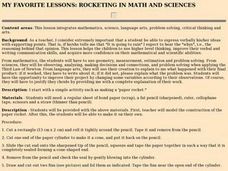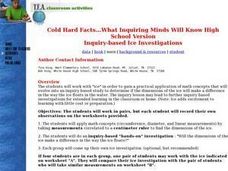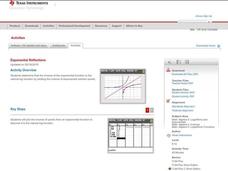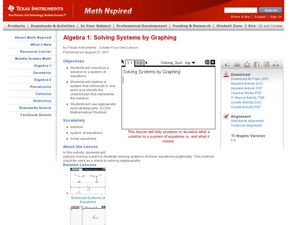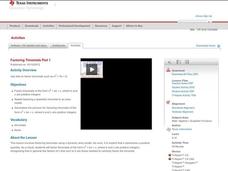Curated OER
Peter The Butterfly
Students complete an interdisciplinary unit chronicling the life cycle and movement patterns of the butterfly. Through language arts, mathematics, and science activities, students identify various types of butterflies and document the...
Curated OER
Load! Ready! Fire!
Students will identify the parts of a cannon and practice demonstrating a mock firing. For this math and science lesson, students read background information on the cannon and its firing. Students read about and role play positions near...
Curated OER
Make-Your-Own Math Practice
Students create their own math practice book. In these homemade book lessons, students create their own counting, number, and shape pages. When the pages are complete, they are bound together in a book.
Manitoba Education and Early Childhood Learning
A Foundation for Implementation
Color is the focus of this amazing resource packed with math, social studies, science, and language arts activities. Kids create a color word wall and post symbols, graph the number of objects they find of each color while on a...
PHET
My Solar System
Orbit diagrams appear to be a work of mathematical art. The simulation helps scholars build their own systems of planets, stars, moons, etc., to observe their orbits. By altering their positions, velocities, and masses, a variety of...
Physics Classroom
Light Intensity
Light intensity varies by the strength of the light bulb as well as the distance to the light bulb. Pupils apply these concepts independently at first. They must solve for the light intensity as either the distance or the wattage of the...
Curated OER
Rocketing in Math and Sciences
Students make a rocket out of paper. They follow the given instructions and test to see if it will fly. They write about the experiment and are given the opportunity to change their varibles to make their rocket work.
Curated OER
Cold Hard Facts...What Inquiring Minds Will Know
Learners work with "ice" in order to gain a practical application of math concepts that evolve into an inquiry-based study. They determine if the dimensions of the ice make a difference in the way the ice floats in the water.
Curated OER
The North (Wall) Star
Students engage in a lesson which shows them that celestial navigation is the art and science of finding one's geographic position by means of astronomical observations, particularly by measuring altitudes of celestial objects - sun,...
Curated OER
What Does Time Have to Do with it?
Students investigate time. In this investigative lesson, students run through an obstacle course using standard timers. They record the time and apply this knowledge to problems in math. Students record their predictions, and graph...
Curated OER
Counting Chart
Elementary learners discover counting through a counting chart. In this math instructional activity, learners identify numbers 1-100. They then point or recite their counting numbers.
Curated OER
Bouncing off the Wall
Students watch a video clips before problem solving the use of angles in real world situations. They problem solve using spatial reasoning while connecting math to a sports activity that investigates the path of a bouncing ball.
Curated OER
Make Your Own Recycled Paper
Paper Lesson Plan - Students discover how paper is made. Working together, they make their own paper. This activity introduces students to recycling; what it is and its importance. Students study the process of how paper is made, and...
Texas Instruments
Transformational Puppet
High Schoolers create a puppet and make predictions using the TI Navigator. In this math lesson, they will discuss their results as they explore transformation. This assignment requires the TI navigator or a smartboard.
Curated OER
Designing a Study
Students explore features to consider when designing a scientific study. In this science research lesson, students examine different methods of data collection and consider which method would be appropriate for determining how many types...
Curated OER
Exponential Reflections
Explore the natural log function through the investigation of inverse of the exponential functions by plotting the inverse of the exponential solution points. Students examine the results to determine that the inverse is the...
Curated OER
Midpoint of a Segment
Learners revisit midpoint and segments by graphing on the TI or computer. This activity can be done with pencil and paper, but is more interactive if it is done on a TI-navigator.
Curated OER
Multiple Representations
Every topic or subject has its own special jargon. Learners work on their math vocabulary as it relates to basic algebra terms. They define and identify function, functional notation, ordered pairs, rate of change, slope,...
Curated OER
Solving Systems by Graphing
Solve systems of equations with your super smart upper graders. They solve systems of equations and then graph two lines to find where they intersect. The focus on the activity is to have learners explore moving a point to...
Curated OER
Cell Phone Range
Here is a 15 minute activity that can be used as review, a warm, or as a quick example of how to relate functions to the real world. Learners complete an application activity and draw conclusion about functions then discuss open and...
Curated OER
Characteristics of Exponential Functions
What can an upper grader do with an exponential function? They can solve and graph it, identify its important characteristic, and differentiate graphs based on shifts in graph bases that are greater or less than one. This 45 minute...
Curated OER
Pythagorean Relationships
Oh that Pythagorean Theorem is so useful. Learners engage in a 45 minute learning activity that requires them to solve for missing angles and sides of a right triangle. They'll use the Pythagorean Theorem to find the rations of sides and...
Curated OER
Factoring Trinomials
Have the class factor and solve trinomials of integers in the form x2 + bx + c, where b and c are positive. They relate factoring to area and then follow a specific format to factor their trinomials. Tiles are used to help them...
Curated OER
Nested Similar Triangles
Nested triangles have been created so that they share a common vertex and vertex angle. Learners drag the endpoints of the side that is opposite the common angle to discover the conditions that make the nested triangles similar. When...








